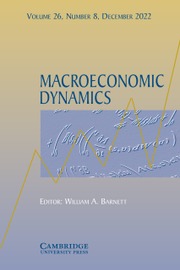Article contents
SEPARABILITY, AGGREGATION, AND EULER EQUATION ESTIMATION
Published online by Cambridge University Press: 16 January 2001
Abstract
We derive a seminonparametric utility function containing theconstant relative risk aversion (CRRA) function as a special case,and we estimate the associated Euler equations with U.S. consumptiondata. There is strong evidence that the CRRA function ismisspecified. The correctly specified function includes laggedeffects of durable goods and perhaps nondurable goods, is bounded asrequired by Arrow's Utility Boundedness Theorem, and has a positiverate of time preference. Constraining sample periods and separabilitystructure to be consistent with the generalized axiom of revealedpreference affects estimation results substantially. Using Divisiaaggregates instead of the NIPA aggregates also affects results.
Information
- Type
- Research Article
- Information
- Copyright
- © 2000 Cambridge University Press
- 2
- Cited by

